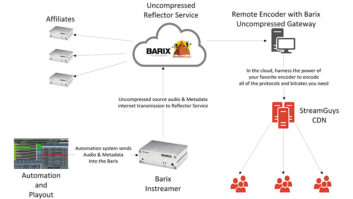
Jinny Laderer
The key to improving a radio station’s bottom line begins simple enough: taking a ground-up, close-up look at where inefficiencies can be found. And according to one industry insider, there are many.
“I am blown away by inefficiencies in a radio station,” said Jinny Laderer, a radio executive and consultant who followed her father into the radio business and is now head of sales, marketing and affiliate relations for the company vCreative, a web-based continuity management software company. “And now, we’ve got to get [things] online and streaming, as well as on air.”
As part of the NAB Show’s Broadcast Management Conference, Laderer laid out some solutions that radio broadcasters can take as part of a well-attended session called “In-Station Innovations that Save and Make Radio Money.”
Upon returning home from the NAB Show, Laderer laid out several areas that stations can review for potential inefficiencies.
AUTOMATE PROCESSES
One of the biggest inefficiencies is the lack of automated processes, Laderer said. So many stations today have individual departments working in individual silos. Sales is tackling a spot one way; traffic is handling that exact same spot in a totally different manner, she elaborated. “All these systems are working in silos, with each department doing their own thing, and they are not communicating and integrating,” she said.
“You want to automate processes that are manual so we can get rid of double entries and can integrate between all of these departments,” she explained.
One of the best, first steps is to look at investing in programmatic technology. But first, she addressed the elephant in the room: the oft-discussed concern that programmatic technology will put radio execs out of a job.
In reality, she said, programmatic technology is going to free up sales people to concentrate on developing more complicated and creative ad spots. “This [is an area] where you reallocate [staff] so they can put together the complicated ad campaigns that are now being requested by our clients,” she said. “New technologies can be intimidating, but programmatic will be good for us. It is going to take the simple transaction — the easy sale — and automate it.”
“If you take it through the process, it will bring revenue in to your stations,” she said. “Any time you can automate a manual process, you can take that time to execute better campaigns,” she said.
INTEGRATE SYSTEMS
After a buy is completed, there are so many individual actions that have to happen: it has to be determined when copy will run, how often, at which stations, and whether the spot will be sent over the air or digital — and then all of those details must be interpreted and placed into a production order, she laid out.
The data that starts at the agency level needs to travel down smoothly so that “when the agency places that copy, it automatically goes into traffic and into automation,” she said. “With complicated [sales] it’s even more complicated.”
In an ideal world, once an order is entered, she said, it should automatically populate into a production order. Stations using this type of integration “are starting to see better results and less errors,” according to her.
CONSIDER THE CLOUD
Think collaboratively, especially if you own stations in several markets, Laderer said. “There’s a voice pool that you can share. You can share traffic directors between markets, and do all traffic out of one location,” she said. Do the same with production, she added. “Consider getting the dubbing done in one location. These are the things you can do with cloud technology.”
Laderer said there is still a major disconnect between the sales that appear in the digital world and those sales that run on-air. As in other industries, the radio industry is still struggling trying to figure out where digital fits in, she said.
“Sales people are leaving [deals] on the table because they don’t think there’s enough clarity [on digital],” she offered. One answer is to turn to a cloud-based, end-to-end system that can integrate all of these systems. “That’s the importance of collaboration,” she said. “If you have multiple stations, you can collaborate within your own company or collaborate in the cloud with outside resources.”
PUSH FOR CREATIVITY
While it’s important to look for collaboration and new models of efficiencies, at the end of the day, she said, it’s not only the technology that improves a station’s bottom line. None of these technological innovations are truly worthwhile unless stations are creating “compelling, creative content,” she said. “Stations needs more time to be more creative to increase their revenue stream.”
“People are your best assets, and creative people are absolutely your best assets,” she stated. If you take that time to become more creative, in the ways that you create and facilitate advertising, it will pay off, she said.
“It takes creativity to do great radio. We have to find efficient ways to be more effective so we can be more creative to increase ratings and increase sales. That’s where we need to be.”
Related:
Time Is Money for Radio Stations










